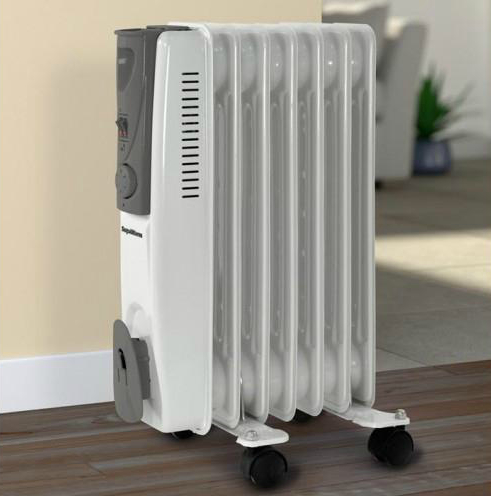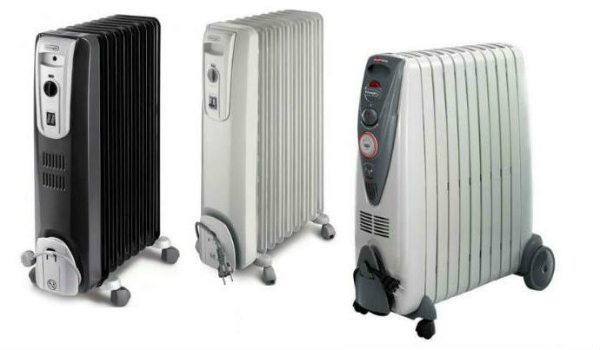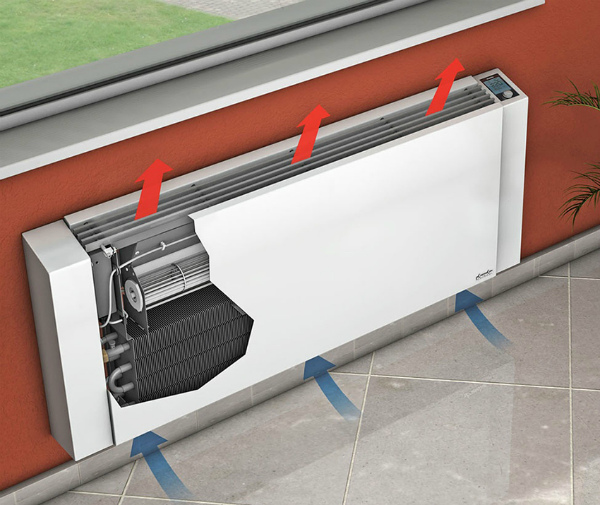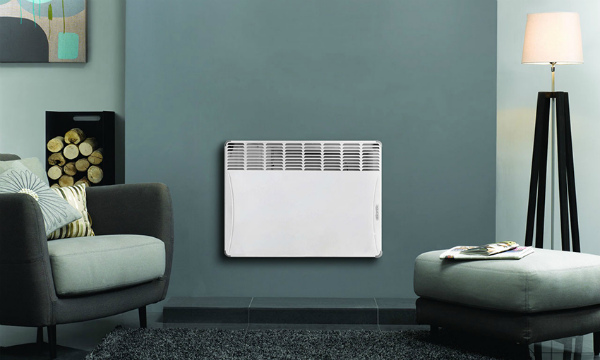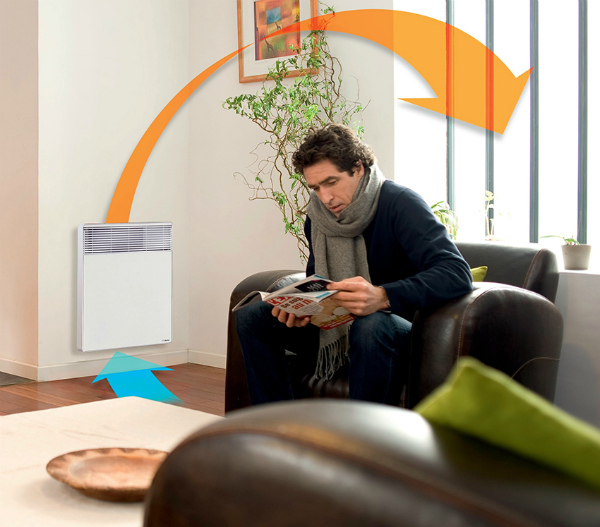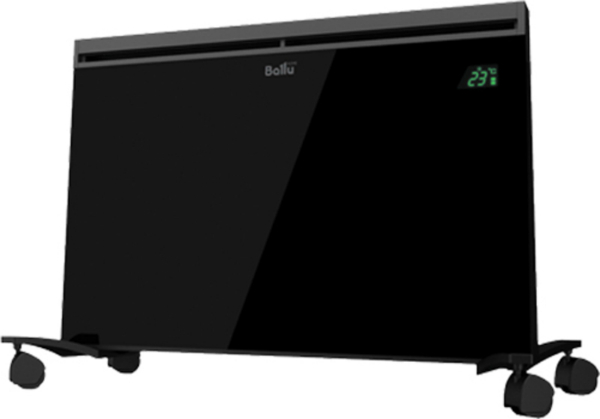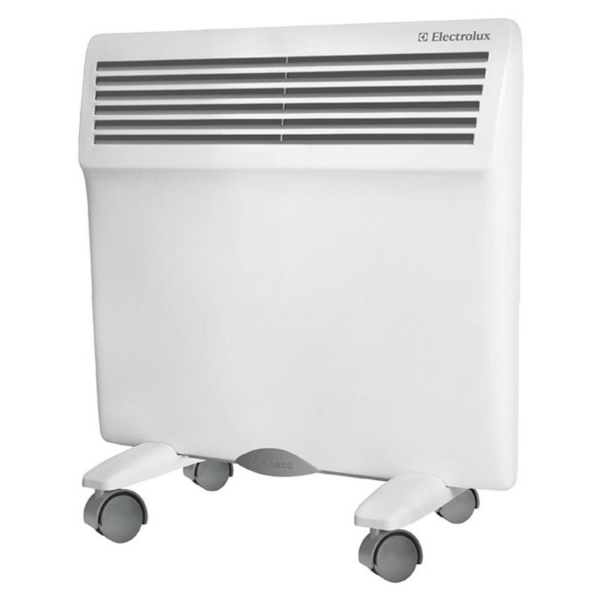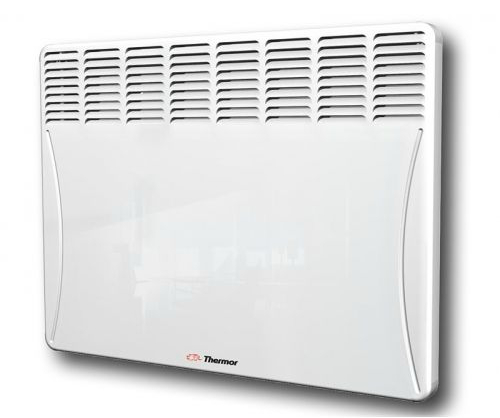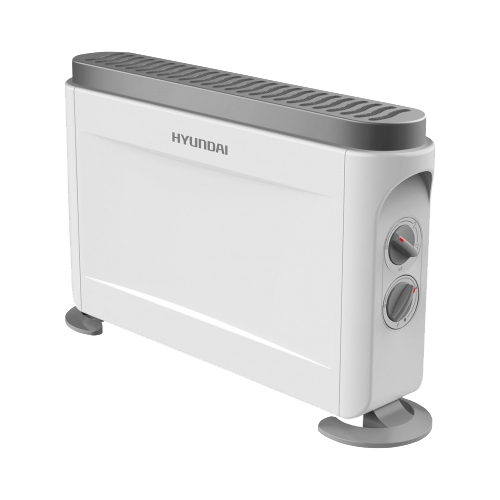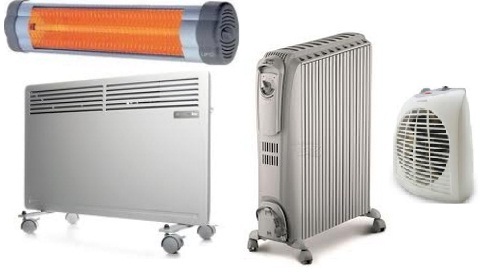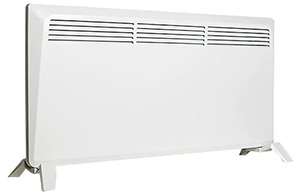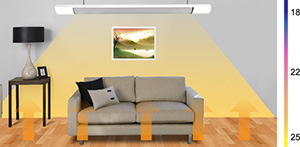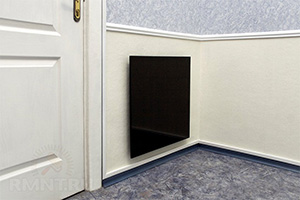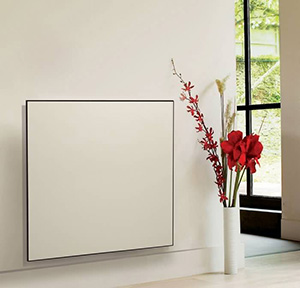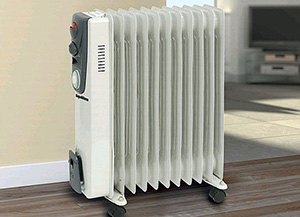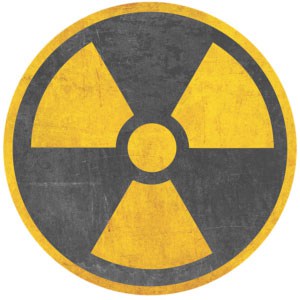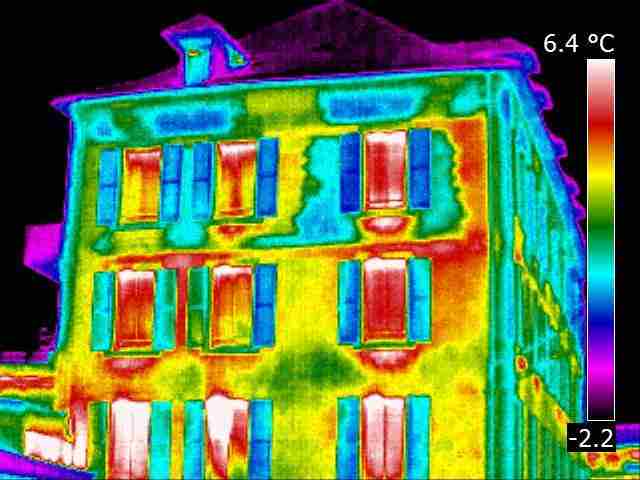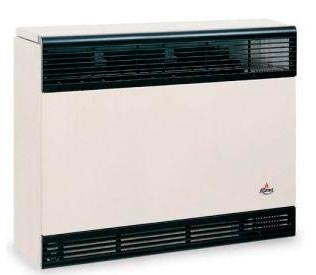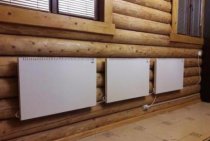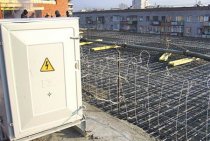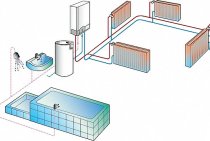Which is better oil or convector
We have already described the principle of operation, advantages and disadvantages of convectors, and now we will get acquainted with the main technical characteristics of an oil cooler. Such devices are most often used to heat air in a private house, in a country house or in a city apartment. To get started, you need to connect the device to a power source and set the desired temperature on the thermostat.
Such a heater consists of a metal housing made in the form of a radiator. Mineral oil is poured into the middle of the container, which heats up and transfers heat from the heating element. A rheostat is built into the device, which allows you to turn off the device when a certain temperature is reached.
The heater is equipped with protection against accidental overturning. In this case, the heating element is turned off.
The benefits of oil coolers include:
- Noiselessness;
- Low cost;
- The ability to move the device around the apartment, to warm up the desired room.
When choosing a radiator heater in a store, special attention is paid to the power of the device. In this case, 1 kW of electricity consumed is calculated for 10 m2 of usable space.
The power consumption range is from 1 to 2.5 kW
Some models have a turn-on timer, which allows you to warm up the premises at the right time.
And now let's get acquainted with the comparative characteristics of these two heaters:
- The first important nuance of choice is profitability. Here it is necessary to give preference to convectors, because they consume 25% less electricity;
- The second parameter is the warm-up time. When turned on, the convector immediately heats the air, its efficiency can exceed 95%. At the second device, the heating element is first heated, then the oil, the metal case and finally the air in the room;
- The next important characteristic is ease of operation (movement). Convectors have small overall dimensions, they can not only be placed on the floor, but also hung on the wall. Oil radiators are massive, their weight can reach up to 25 kilograms, they are unsuitable for wall mounting. The unit has wheels for more comfortable movement, and if you need to bring the unit to the 9th floor in a building with an inoperative elevator;
- Period of operation. According to the technical specifications, the convector can last at least 5 years, but in practice it turns out more. High-quality oil coolers also have a huge motor resource, but cheap Chinese models can crack in the metal, which leads to oil leaking from the body;
- And the last characteristic is the price of the device. Here the undisputed leader will be oil heaters.
A convector is a better option than an oil cooler
Conclusion: When comparing these two heaters, it is recommended to give preference to convectors.
Scatter blankets around the apartment
The more warm blankets in your apartment, the better. They can lie on every sofa and every chair. They began to freeze - threw a blanket over their shoulders, warmed up - put the blanket aside. Plus, cute blankets are stylish interior items.
By the way, plaids with sleeves are now popular: they are very convenient to read a book, work at a computer or drink hot tea.
You can find a warm, beautiful and cozy blanket made of natural wool in the Perina Peroni bedding salon.
Plaid "Paters" in "Perina Peroni" From 5 870 rubles. +7 (343) 302-14-06
Plaid "Paters" in "Perina Peroni" From 3 650 rubles. +7 (343) 302-14-06
How to choose for a summer residence
When choosing the considered heater for operation in the country, you should pay attention to the following parameters:
- Safety of using the device;
- Durability indicators;
- Price;
- Economical use of electricity or other heat carriers.
When choosing between a wall-mounted and floor-standing model, the fact of using the device must be taken into account. Many types of electric convectors are fixed on the wall surface, but if there is a need to move the heater, it will be necessary to purchase additional equipment (wheels, protection against heating during accidental tipping)
The height of floor convectors does not exceed 20 centimeters, they are narrow and long. Wall models reach 50 centimeters in height. According to experts, devices that are as close as possible to the floor surface have maximum efficiency, because the heated air moves from top to bottom. In this regard, it is better not to buy wall-mounted equipment, or to install such devices as close to the floor surface as possible.
When buying such devices, it is necessary to pay special attention to the material and workmanship of the case, its overall dimensions, and design.
Here you need to take into account the height of the case: the larger it is, the greater will be the speed of the air flow or the convector properties of the heater. Skirting convectors up to 20 centimeters in height warm the air well due to their significant dimensions, their length can reach up to 2.5 meters
A taller (up to 60 centimeters) heater will be more compact, in which the speed of air flows increases
Skirting convectors up to 20 centimeters in height warm the air well due to their significant dimensions, their length can reach up to 2.5 meters. A taller (up to 60 centimeters) heater will be more compact, in which the speed of air flows increases.
It is better to install the convector closer to the floor
Buy an electric blanket or sheet
Lie in a cold bed? Even thinking about it is unpleasant. It happens that you cover yourself with three blankets, but you still can’t get warm and fall asleep. To sleep only in a warm bed, use an electric sheet or blanket. They are equipped with special heating elements and have several temperature regimes. Turn on the sheet 15-20 minutes before bedtime and go about your business. Come back - and the bed is already dry and warm.
Electric sheets are completely safe, because they are equipped with an automatic shut-off system, while you choose the time yourself (usually the sheet should be turned off after three to seven hours of operation).
The power of the sheet is 40–100 watts, but a lot depends on the model and size of the device. And, by the way, the electric sheet can be washed (the cable with which the sheet is heated is removable).
Hang blackout curtains open in the morning and close at dusk
With the onset of winter, thin curtains on the windows should be replaced with thick curtains and closed as soon as it starts to get dark outside. Thick curtains will play the role of a thermal insulator and protect the house from cold air currents. This is especially true if the windows are blown through (unfortunately, not only old wooden windows, but also some modern plastic ones sin with this).
During the day, the curtains need to be opened, while the wider the better. Through the window, sunlight and heat will enter the room. It is clear that the temperature will increase by a maximum of 1-2 degrees, but still being indoors at lunchtime will be much more comfortable.
Stylish blackout curtains of dark gray or chocolate color from the Mebelion home goods store will help to keep warm and create coziness in the apartment.
Curtain Primavelle in Mebelion From 2 800 rub. +7 (800) 707-47-67
Curtain Mona Liza in Mebelion From 3 250 rub. +7 (800) 707-47-67
floor standing
Convector Ballu BEP/EXT -1500
designed to heat rooms with an area of 20m2. This device operates on a 220 volt power supply, has several power switching modes, which allows you to achieve the optimal temperature for heating the room. The model is equipped with special wheels for easy movement around the room, there is protection against overheating and accidental tipping, there is a control panel and a timer. The price of the model is 4220 rubles.
The advantages of the model are: beautiful appearance, the presence of a 3-year warranty for the product, low power consumption.Cons: clicks are heard when the thermostat is working, an unpleasant smell during the first warm-up, bright display.
Ballu BEPEXT -1500 differs from the previous model in dimensions and power
Convector Electrolux ECH/AG-1000MFR
with a power of 1 kW is designed for heating small, including wet rooms with an area of 15m2. The control in this device is mechanical, it is possible to control the temperature, there is a dust filter, as well as protection against overheating. The heater has a moisture-proof housing, the price of the model is 2450 rubles.
The advantages of Electrolux ECH/AG-1000MFR include: excellent functionality, fast heating of the room, small overall dimensions, absence of extraneous odors during operation of the device. No deficiencies found.
Convector Electrolux ECH/AG-1000MFR
With a power of 1.5 kW, it is designed to heat rooms with an area of 15m2. This model has electronic control, it is possible to adjust the temperature in automatic mode. The device has a waterproof case, there is protection against overheating and frost. The price of Thermor Evidence 2 Elec 1500 is 4400 rubles.
The main advantages of this convector are: beautiful appearance, ease of use, quick heating of rooms, can withstand significant voltage drops. The disadvantages include the high cost of additional equipment.
A heater with two heating elements of 1.25 and 0.75 kW can operate in three modes. At maximum power, it is possible to heat rooms with an area of 24m2.
The device is connected to a 220 volt household power supply, equipped with a digital display, has a mechanical control. The device has built-in protection against overheating, its price is 1590 rubles.
The advantages of the Hyundai H-HV14-20-UI540 include affordable cost, the ability to save energy by turning off the temperature switch when the room is heated intensively, fast heating, small dimensions and weight. Disadvantages: extraneous odors when the device is first started, high case temperature, thermostat clicks.
Heater selection
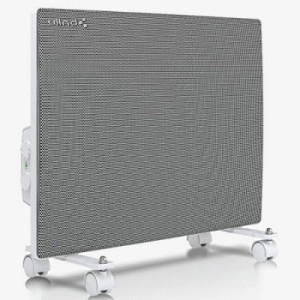
When choosing a heater, you need to pay attention to reliable and proven brands. These include products from UFO, AEG and the international holding Polaris
A wide range of models will allow each person to choose the right product.
Throughout the entire period of use of the device, the basic requirements for its operation should be met, then it will serve trouble-free and for a long time.
Video about carbon heater
In the cold season, the purchase of a heater becomes relevant. The capacity of central heating systems, the performance of boilers in severe frosts is often not enough. Buying a heater will allow you to maintain a stable temperature in the room, sufficient for a comfortable stay of people in the room.
When choosing a heater (we wrote earlier how to choose the right model), users pay attention not only to power, type and cost, but also to other features. An important criterion is the level of comfort from the operation of the device.
Preference, in this case, is given to models that do not dry the air.
Does the convector dry the air
The burning of oxygen that occurs during the operation of heaters is a common misconception. This is due to the subjective sensations that arise during the operation of heating devices. Simple heating, without the use of specially designed installations used in construction work, is not able to remove water particles from the atmosphere.When the temperature rises in an enclosed space, the relative humidity naturally decreases, causing unpleasant sensations of moisture deficiency and lack of oxygen, but the absolute humidity in the room remains the same.
ATTENTION! The convector heaters produced at the present time are free from the disadvantages of drying the air, since they do not have a fan - the heated oxygen coming out of them naturally dissipates without affecting the distribution of moisture in the room. And due to the built-in flat low-temperature heating element, the possibility of burning dust particles is completely excluded and a pleasant feeling of freshness and purity of air is created
Heaters that do not burn oxygen
1. Convectors
The device of electronic devices of this group is not difficult. Their heating element is built into a hollow body. The principle of operation is based on the natural circulation of air flows around the room. That is, cold masses fall down, pass, among other things, through the convector, where they heat up and rush to the ceiling. Some models have a built-in fan that increases the heating rate of the room, thereby increasing the efficiency of the devices. For more information on different types of convectors, see this article.
2. IR heaters
Infrared devices are also presented in various modifications - lamp, mikathermic, panel, ceramic. They also include films that are used in underfloor heating schemes. All of them are characterized by an identical principle of operation, which distinguishes them from all other types of heaters. If numerous analogs increase mainly the air temperature (up to 85% of the energy is spent on this), then IR devices are the surface on which their reflector is directed. Those, in turn, give off heat energy to the room. Consequently, the process of oxidation (and by this is meant the "combustion" of oxygen) does not occur. In terms of efficiency, infrared heaters occupy a leading position among devices in this category. Read more about products that heat using infrared rays here.
3. Ceramic
By definition, they do not dry the air, since they do not contain an open heating element. The heating element is covered with a ceramic shell, which prevents the combustion (and, in fact, the oxidation process) of oxygen. The fins on the body increase heat transfer, thereby helping to reduce the temperature of the "shirt" of the device.
4. Oil
In many articles, these devices are indicated as heaters that do not “burn” oxygen. How true is this? If all the listed types of electric / heaters do not really dry the air, then this cannot be said about oil analogues. After turning on the powerful model, after a while the room becomes stuffy. People who do not understand the principle of operation of such devices explain this by their high efficiency. But what really?
Structurally, the heater of this group is a body with fins, inside of which there is a container with oil and a heating element. As the temperature rises, heat is transferred to the surrounding air. A significant plus is that after disconnecting from the mains, the oil cooler cools down slowly, and the heating of the room continues by inertia, although its intensity decreases as the case cools. But there are more cons.
- The jacket of the appliance gets very hot. It is quite easy for a child (and the skin of babies is hypersensitive to external influences) to get burned, which often happens.
- With prolonged use of an oil heater, air humidity is reduced to 40%. What this means is easy to understand if you know that the minimum allowable value of this parameter in residential premises (according to SanPiN) is 60 and 65% (for the cold and warm seasons, respectively).
The fact that the oil cooler does not burn oxygen is true, but the air definitely dries. As a rule, such devices are used only for short-term switching on, and it is not worth considering them as an option for long-term heating of a room, unless a number of measures are taken.
So what is it then
Regardless of the material of radiators and their design, the vast majority of radiators radiate about 80% of the heat produced by convection, as a result, only 20% remains for thermal radiation. Don't worry, there's nothing wrong with this ratio. Some experts mistakenly believe that this ratio is 50/50.
Radiators were invented by Russian businessman San Galli, although some people still dispute his invention.
He called them "hot boxes", which is a fairly accurate description of a radiator. A warm box that moves air around it and raises the temperature in the room.
In the US they are called heaters. It is worth noting that Americans use a more accurate term derived from the word “heaters”. After all, this is exactly what radiators do - they heat and give off heat.
The scientist will refer to heat as thermal energy, which can move in space by conduction, convection or radiation. Your home aluminum radiator mounted on the wall under the window heats the cold air above it, and with the help of the slightest drafts from the window, convection currents move the heat around the room.
How does a radiator heat a room?
Convection currents are created when the air above a heatsink heats up, then cools down, and then heats up again. This process takes place continuously as long as you have the heating on. In this way, radiators move heat around the room, which makes the house warm and cozy. To put it scientifically, heat is created due to the transition of potential energy into kinetic energy.
When a heating radiator heats up the air, it causes the atoms to vibrate at a high frequency. The atoms continue to vibrate faster and faster, resulting in the creation of thermal energy. This process is known as convection.
Oddly enough, the term “radiator” fits underfloor heating much better. Because this system actually radiates heat throughout the room. More than half of the heat generated by underfloor heating systems is produced through radiation.
Get the most out of your radiator
Given that the radiator is working to create those beautiful convection currents while you're watching football, it's worth making sure the heat stays inside the house. This will save energy, money and heat. Thermal energy, like Houdini, likes to disappear unnoticed.
It can go through the roof, windows, walls and any small gap invisible to the human eye. Are your poor bimetal radiators (or hot boxes) working so hard and you're letting the heat out of the house? Do not do this!
Install attic insulation, insulate wall cavities, and make sure windows are in good condition. This will keep the atoms inside the room and prevent them from escaping into the street, taking precious degrees of heat with them.
2 Karma Beta Mechanic 5
High power and reliable performance
Country: Czech Republic
Average price: 24,980 rubles.
Rating (2017): 4.5
The second place in the ranking of the best gas convectors is occupied by Karma Beta Mechanic 5. The power of this productive device is 4.7 kW, thanks to which it can be used to heat rooms up to 50 square meters. The closed combustion chamber ensures safe operation, and the steel heat exchanger quickly heats the air. Wall mounting greatly simplifies the installation process - the convector takes up minimal space.
And you know that...
There are two main disadvantages. Warm up the air for a while.The heat is known to rise, so we can still feel cold at our feet while our head is glowing. If, in addition, we need to let out, the heat escapes through the window and we heat it up again. Another disadvantage is that it warms the air, leaks allergens, burns dust and dries the air, creating an environment unsuitable for people with allergies and those suffering from respiratory problems.
On the same principle as hot water heaters, hot air fans also work. But the advantage is that you can aim them exactly at the spot in the space that you want to heat up for a while, so you don't have to heat up the entire room.
The advantages in the reviews, users include a wide range of temperature adjustment, quiet operation and high efficiency. The device is equipped with a piezo ignition, which allows it to be used without electricity. Both natural and liquefied gas can be used as fuel. The weaknesses of this convector are large dimensions (weight 30 kg) and poor assembly.
Warm gadget on wheels - oil coolers
These devices look like a regular radiator connected to a central heating system. They are on wheels and connected to the network. The big advantage is their very easy installation, maintenance and power control. Moreover, they do not breathe air and do not trust dust.
They work on a simple principle: a heating coil inside the oil is heated, which delivers heat to all the fins and heats the air in the room. The larger the room, the more space is required for the rib. The negative side is the high power consumption. If you used an oil cooler all the time, you would be overhead.
Which heaters do not burn oxygen
Let's talk about which heaters do not burn oxygen.
Convectors
Convectors are the best. We add that Electrolux heaters equipped with special filters are useful. Timberk produces convectors with humidifiers as an option. This normalizes the microclimate, more suitable for the south of Russia than for the middle zone, overgrown with forests.
Infrared heaters
Ceiling-type electric infrared heaters are praised. Two varieties are created:
- Lamp.
- Ceramic.
The first do not differ from fluorescent lamps. Inside behind the bars is a long glass flask with a spiral. According to science, before the operation of the specified heater, you need to brush off the dust from the lamp and reflector, in practice this is done less often, the process is hampered by the grate.
Against this background, ceramic infrared heaters look more profitable. They resemble fluorescent lamps, instead of gratings there are protective panels, but not glass. The smooth surface represents steel coated with ceramics. The design behaves in properties like a completely black body. The maximum radiation falls on the infrared range. This class includes Peony, Bilux and Icoline products.
Gas infrared space heaters are a good solution. For example, fireplaces that work on the infrared principle. Inside, behind heat-resistant glass, a flame burns, red-hot the ceramic grate. Heat radiation begins. Gas is supplied from the outside, you will have to drill a wall under the yellow pipe, in addition, you need to take air from the street and throw out the combustion products. This requires an additional hole for the coax. This is a double trumpet - singing inside the second one. Such a technique will make it possible to get by with a single hole in the wall (together with a yellow pipe, two are obtained).
Think about whether it's worth trying so hard just to get a good fireplace. This is an expensive device, beautiful. A gas fireplace is called a device that has a decorative effect and is efficient as a heater.
There are gas convectors, they do not dry the air too much, but they are inferior to fireplaces in beauty (and price), and you still have to make holes in the wall. If you are already thinking about climate issues, you should not take models
Please note that selected gas cylinder fireplaces take air from the room and throw it back. These heaters burn and dry the air.
But! When gas is burned, water vapor is formed, the losses are replenished. In addition, tetravalent sulfur oxide is formed, forming sulfuric acid in moist air. Such devices are good in the country, in nature, where a crowd of people go to have fun and relax.
3 Timberk TEC.E0 M 1500
Popular budget convector for home
Winter knocks lightly on the door, and after a rather warm autumn, we put on our clothes and turn on the heating at home. But there is a situation where we want to enjoy the comfort of warmth only for a certain time or in a certain place. In this case, smaller spot heaters are useful. However, sometimes it is difficult to know which are the most suitable for our purposes.
You can choose from two types of heat dissipation. Heat air, walls, objects and people. Every kind of warming has got into it, so it's good to think about it which suits you. Consider how much space you want to heat. Other criteria will be withdrawn at the end of the article.
How to choose the right electric convector that does not burn air
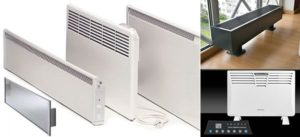
- Power consumption. The choice is made taking into account the size of the room in which the device is planned to be installed.
- A heating element. In convector heaters, elements of the tape type, heating elements or monolithic ones are possible. The monolithic heating element proved to be the best in providing the room with warm and high-quality oxygen.
- Device installation options. There are two options for installing convectors - floor or wall. If the heater is planned to be transferred from one room to another, then you should choose the floor version, which has support legs with wheels. Support legs are also available without wheels.
- Temperature controller. The presence of a thermostat makes it possible to regulate the intensity of heating, reduce and add power to create the optimal temperature in the room. For greater convenience, it is recommended to give preference to an electronic switch.
- The presence of a thermostat will allow you to maintain the desired temperature.
- Device dimensions. The air circulation rate depends on the height of the device - the lower the convector itself, the higher the air flow rate, respectively, the room will warm up faster. Long plinth-type convectors are capable of significantly warming up the lower part of the room.
- Safety. An additional bonus of the low temperature of the heating element can be considered the safety of the device. Indeed, due to the fact that the case is heated to a maximum of 60 degrees, there is no possibility of getting burned. It is also possible to choose a device with rollover protection and a body that has a smooth outline without sharp corners. Such a convector will be the best choice if there are small children in the house.
- The built-in timer allows you to set a specific time to turn on and off the device.
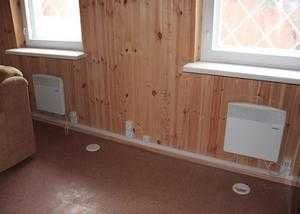
IMPORTANT! When the device is turned on, moving oxygen will move dust particles along with it, which will settle between the convector plates - in this case, you will have to forget about fresh air.Maintaining cleanliness in the room with the help of regular wet cleaning and caring for the device itself, removing settled dust from it in a timely manner with a vacuum cleaner, it is possible to create an optimal microclimate in the room with a comfortable and stable temperature.
Maintaining cleanliness in the room with the help of regular wet cleaning and caring for the device itself, removing settled dust from it in a timely manner with a vacuum cleaner, it is possible to create an optimal microclimate in the room with a comfortable and stable temperature.
